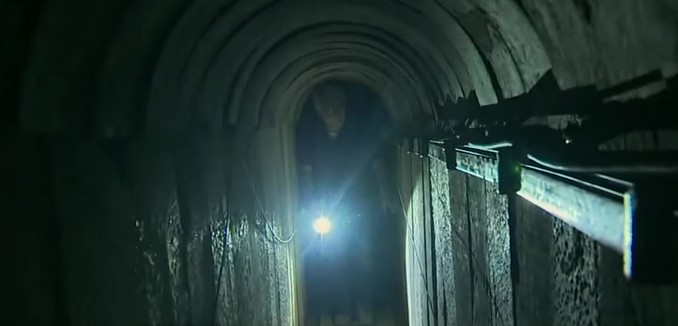At least three Hamas operatives were killed on Sunday when a tunnel collapsed in the southern Gaza Strip, according to Palestinian media reports. The collapse was the twelfth reported this year as Hamas continues to rebuild its terror infrastructure in the aftermath of its 2014 war against Israel.
Israel Radio reported last week that Hamas currently pays over 1,000 operatives to build tunnels and “invests hundreds of thousands of dollars each month in digging activities.” According to The Guardian, in December 2014, Hamas “formed a special unit to dig and equip tunnels and train fighters to use them.” The paper also reported the terrorist group was “preparing for another war.” Last summer, an IDF commander warned on Israel Radio that Hamas was rebuilding its network of terror tunnels. Israeli residents near the border with Gaza said that the tunnel digging was “shaking” their floors in January. Israelis have also reported hearing “renewed construction noises under Israeli territory.”
Ismail Haniyeh, Hamas’ deputy political bureau chief, vowed in January to continue digging tunnels in preparation for a future conflict with Israel and said that the tunnels have become a “strategic weapon.” As reported by Al-Monitor, Haniyeh declared that during the summer 2014 conflict, “underground tunnels brought death to our enemy and victory and glory to our people and nation.” He continued, “It is from these tunnels that the mujahedeen carried out the Nahal Oz operation. From these tunnels, the mujahedeen went behind enemy lines…and returned safely to their bases.” In an attack on an Israeli military post near the kibbutz Nahal Oz, Hamas operatives used their tunnel network to infiltrate the base and kill five Israeli soldiers.
After continued Hamas rocket fire in the summer of 2014, the IDF launched Operation Protective Edge (OPE). The Israeli military explained during OPE that Hamas intended use the tunnels “to carry out attacks such as abductions of Israeli civilians and soldiers alike; infiltrations into Israeli communities, mass murders and hostage-taking scenarios.” The IDF stated that eliminating the tunnel threat “was a primary objective” of OPE, and during the conflict, it destroyed 32 tunnels. Haaretz’s defense correspondent Amos Harel wrote in January that “Hamas is investing great efforts and huge sums in the tunnel project. It is reasonable to assume that the number of tunnels crossing under the border is close to that on the eve of Protective Edge.”
Hamas is the effective government in Gaza, meaning that the West Bank-based Palestinian Authority does not have complete control of the territory it purports to rule. This renders the establishment of a Palestinian state currently impossible, even if the PA reaches an agreement with Israel.
In Your Complete Guide to Hamas’ Network of Terror Tunnels, which was published in the April 2016 issue of The Tower Magazine, Dan Feferman observed that the people of Gaza pay the price for Hamas’ efforts to rebuild its terror tunnels.
There is a tragic side to Hamas’ tunnel strategy. Roughly 9,000 homes were destroyed during Protective Edge, and very few have been rebuilt. This is not Israel’s fault, as building supplies flow regularly into Gaza. But according to declassified intelligence reports, these supplies are routinely stolen by Hamas in order to serve the group’s terrorist purposes. Hamas smuggles in cement, diverts from construction and humanitarian donations, and even raids civilian construction sites in order to rebuild its tunnels. Estimates are that one tunnel can cost a million dollars to build and uses around 50,000 tons of concrete. Close to a million tons of concrete were poured into the terror tunnels before 2014.
The tunnels, in this sense, are a zero-sum game. If the same materials were put into reconstruction, the Gazan people would be better off and, lacking this crucial asymmetric warfare capability, Hamas would be less tempted to attack Israel. On the other hand, with the same limited materials going to terror tunnels, the people of Gaza continue to live in ruins while Hamas rebuilds its war machine.
While Hamas appears to be deterred in the short term, it continues to believe that the tunnels are its only strategic weapon. While it may not be interested in another war, the tunnels continue to be dug for a reason. Once used, however, they lose their effectiveness, as the IDF knows their locations and can thus destroy them. Hamas is well aware of this dilemma. The tunnels essentially leave Israel and Hamas in an arms race—with Israel racing to develop a technological solution before Hamas decides to launch another round of fighting.
[Photo: CNN / YouTube ]




